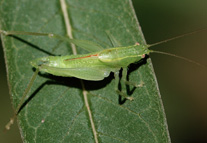Abstract
New species of Amytta are described from East Africa. Beside tegminal length, they differ mainly in the structure of the complicated male genitalic organs, notably the last abdominal tergite and cerci. Data on habitat and the acoustics of some species and a key to the species are provided. The songs of all seven Amytta species studied are very similar, consisting of long trills with a syllable repetition rate of about 60 Hz (at 20ºC) and a broad frequency peak in the ultrasound at around 40 kHz. The biogeographic pattern and phylogenetic relationships are discussed for the group.
References
Karsch, F. (1888) Die Meconemiden. Ein orthopterologischer Beitrag. Wiener Entomologische Zeitung, 7 (4), 159–162.
Beier, M. (1965) Die afrikanischen Arten der Gattungsgruppe „Amytta“ Karsch. Beiträge zur Entomologie, 15, 203–242.
Beier, M. (1967) Neue Beiträge zur Kenntnis der Gattungsgruppe Amytta Karsch (Orth. Meconematinae). EOS, 42, 305–310.
Hemp, C. (2001) Two new species of Amytta Karsch (Orthoptera: Meconematinae) from East Africa (Tanzania, Mt. Kilimanjaro). Journal of Orthoptera Research, 10 (1), 133–138.
https://doi.org/10.1665/1082-6467(2001)010[0129:tnsoak]2.0.co;2Hemp, C., Voje, K., Heller, K.-G. & Hemp, A. (2009) Biogeography, phylogeny and acoustics of the flightless bush-crickets of the East African genus Monticolaria Sjöstedt, 1909, with the description of a new species (Orthoptera: Phaneropterinae). Zoological Journal of the Linnean Society, 156 (3), 494–506.
https://doi.org/10.1111/j.1096-3642.2008.00490.xHemp, C. & Johns, P. (2015) Libanasa kilomeni, a new species of East African Lutosinae (Orthoptera: Anostostomatidae). Zootaxa, 4032 (4), 435–443.
https://doi.org/10.11646/zootaxa.4032.4.8

